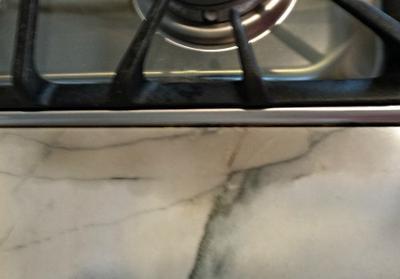Installation Adhesive Stains on White Carrara Marble
QUESTION:
We just had a honed Carrara marble countertop installed in the kitchen.Looked great until I noticed these blue-gray stains around the cooktop, sink, along some edges, and a couple other spots in the middle.
The builder was told it was from the adhesive that was used to help attach it and should disappear. Your thoughts?
ANSWER:
Hmmmmm.... "We made some glue stains on your countertops, but they should go away."Well, your answer should be... "Okay... then I'll pay you when they do."
Countertop installation adhesive stains can appear with the use of certain adhesives and chemical additives to the glue used for attaching the marble countertop to the cabinets.
All stains in marble are dark spots, but glue stains from installation are unique.
Installation glue stains are also called "green bloom" since commonly the stains have a green color (but can be grayish or bluish as well), suddenly appear without apparent cause and sometimes grow.
The additional chemical is used to accelerate hardening of the adhesive but isn't really necessary.
The choice to use accelerants must be considered carefully due to the possibility of these stains. Stains don't always occur but are completely unpredictable. Excessive or sloppy application can be at fault as well.
Here's what happens.... The marble stains occur when the glue leaches through the slab from the underside (the side that is glued to the cabinets) through the full thickness of the slab to appear on the countertop surface or
The stains are noticed most often near the front edge and/or backsplash, around cooktops and sinks, along seams, or in a definitive pattern in the middle because this is where and how the adhesive is applied.
Green bloom marble or granite glues stains are a unique type of stain. All other marble stains originate from the top surface where something spilled absorbs into the natural stone.
Countertop adhesive stains usually appear within a day after installation, but can take a few days in some instances.
This type of blue - green glue stain may evaporate enough to become unnoticeable, but it can also be permanent. Meaning residue from the glue continues to absorb through the marble maintaining the stain. Also, the stains tend to spread and darken over time.
A stain removal process is typically required which can take some time to perform and is usually, but not always, successful with this problematic stain type.
Different methods can be tried. Rather the same procedure is used in every case, however, the most effective chemical ingredient used to remove the marble glue stains can vary.
Detailed instructions are provided in our How To Remove Stains marble maintenance manual.
Or use this Green Bloom Glue Stain Remover Kit made for this issue.
You may consider the Cleaning Marble Secrets Guide instead though. It includes the "Remove Marble Stains" guide along with everything else you'll want and need to know to properly clean and maintain your marble the right way.
Comments for Installation Adhesive Stains on White Carrara Marble
|
||
|
||
|
||
|
||
|
||
|
||
|
||
|
||
|
||
|
||
|
||
|
||
|
||
|
||
|
||
|
||




